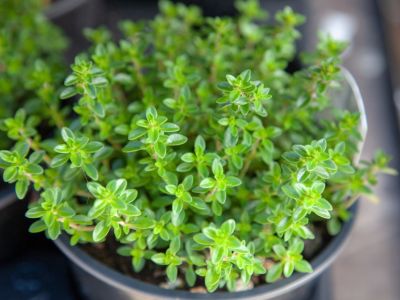Planting Thyme Indoors
Thyme is both a culinary and aromatic herb. An excellent container for growing thyme is a clay planter. Other types of pots will suffice, but a clay pot will allow the thyme herb to dry out between watering and prevent overly wet roots as thyme isn’t tolerant of soggy root conditions. The container should have at least one large drainage hole. A good mix of sand, potting soil, peat moss and perlite will provide adequate nutrients and drainage. Thyme can tolerate indirect light, which makes it perfect for the kitchen herb garden. The best results will be found when thyme is planted where it receives six hours of daylight. Once the thyme has been planted, place the container in a southern- or western-facing window if possible. Growing thyme inside will require temperatures in the daytime around 60 F. (16 C.) or more.
How to Grow Thyme Indoors
Herb care for plants indoors is much the same as for those outdoors. Water completely each time but allow the pot to dry before watering again. Fertilize thyme with a weak solution of fish emulsion or liquid seaweed, diluted by half every two weeks. Cut back overly woody stems on the thyme plant to force fresh new growth. Trim off flowers and dry them for a sachet or use them in tea. Removal of flowers increases foliage production.
Potted Thyme Care
Container grown thyme needs to be repotted every season or two depending on the size of the pot and rate of growth. You’ll know it’s time when the roots are growing out of the bottom of the container. Thyme plants divide easily when repotted to reproduce even more plants. Thyme growing indoors will benefit from relocation to the outdoors in summer. Begin by exposing the potted thyme to a semi-shade location to acclimate it to outdoor light and temperatures. Gradually move it to full sun.
Using and Harvesting Thyme
Growing thyme indoors allows you to have a constant ready supply of fresh seasoning. You can start using your thyme as soon as the plant has plenty of foliage. Cut off the stems and rinse them. Pick off the leaves or simply run your thumb and index finger down the length of the stem to push off the leaves. Chop the leaves or add them whole to sauces, soups and other dishes. The stems can be stewed in stock to release their flavor but remember to strain them out. Thyme leaves can also be dried by spreading them on a cookie sheet for a day or so in a warm dry area.
